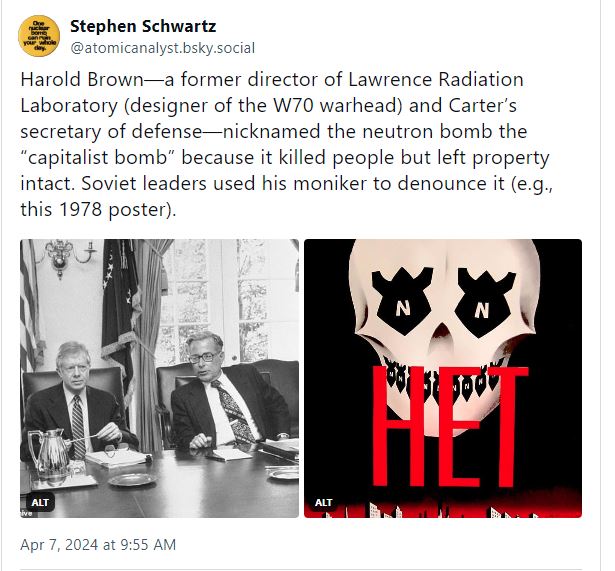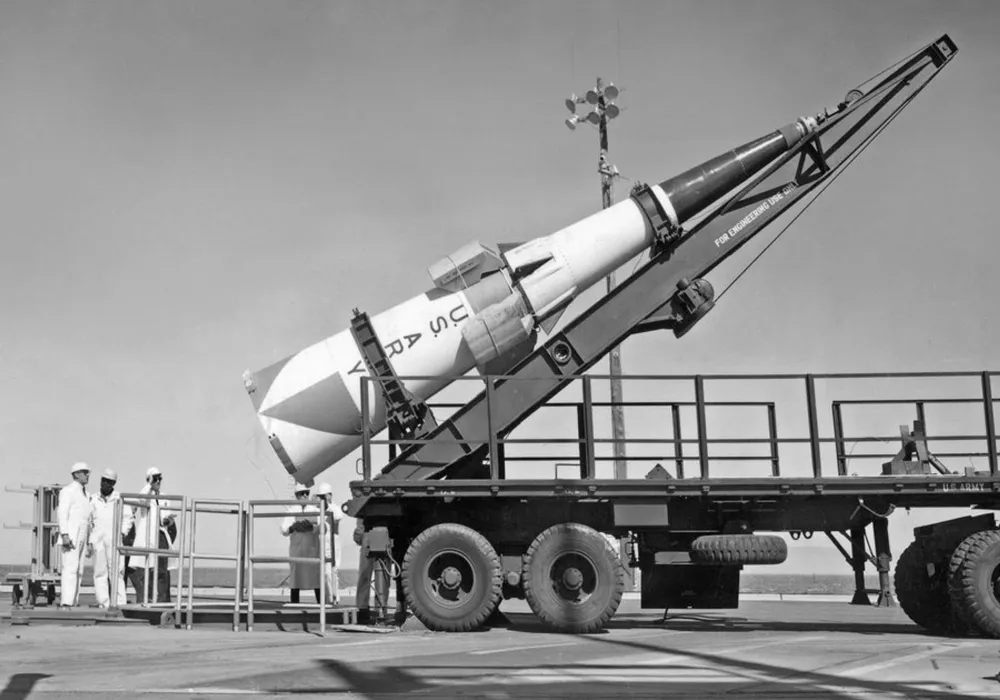In fact, death rays do not exist. Not neutron bombs, not whatever is causing Havana Syndrome (Anomalous Health Incidents). I am sad to be the bearer of these tidings, but whatever role a death ray pistol plays in your fantasies, it will have to stay fantastic.
The big problem is the amount of power required for your typical death ray, if you assume that there are physical and biological principles that allow killing people without leaving a mark. I’m not saying it’s impossible, just that nobody has shown how it works, the energy interaction with the human body.
Yes, neutrons can fry living organisms. But what does it take to produce those neutrons?
Stephen Schwartz posts on the history of nuclear weapons. He’s on Bluesky, not Twitter, and worth following if that’s one of your interests. Today he posted a thread on the neutron bomb.

Harold Brown knew better, of course, but hype is hype. The sticking point for me has always been that a neutron bomb is still a nuclear bomb, and their explosions are not small. So yes, a neutron bomb will cause property damage within some radius, with neutron damage alone past that radius. Which ignores the fires ignited by the nuclear blast. And all nuclear weapons may inflict some neutron damage beyond the blast radius.
But hype is hype.
If Harold Brown said it, it must be true, and most reporters have no idea of how nuclear weapons work. So the reply guys love to add “What about a neutron bomb?” to threads about warfighting and whatever.
I commented that I would love to see a good explanation of how neutron bombs work, and Stephen came through. I am linking that rather than a screenshot because it contains a page from Volume I of the Nuclear Weapons Databook (1984). That page tells me what I wanted to know.
The neutron bomb uses deuterium with tritium, rather than lithium-6 deuteride, as the fusion material to maximize the release of fast neutrons…Such neutrons from fusion are up to six times more numerous per kiloton of energy release than are neutrons escaping from the fission reaction in a fission bomb.
Consequently, for a given explosive energy release, it is possible for a lethal dose of nuclear radiation to be delivered on the battlefield for a somewhat greater distance in the case of a neutron bomb than for a fission bomb. The lethal radius for a neutron bomb’s radiation dose for a low altitude burst is about 700 meters. This is about twice the lethal radius of a fission weapon with the same yield and about the same lethal radius as a fission weapon with ten times the yield.
The Databook compares the neutron bomb’s radiation output to that of a fission weapon. The difference will be less for thermonuclear devices. The text tippytoes around classified bomb variables. Certainly specific bomb types would not be compared in an unclassified discussion.
For intermediate and large yields, the destructive radius of the blast generally far exceeds that of nuclear radiation. The blast damage radius drops off more rapidly with decreasing yield than the lethal radius of the radiation. Only in the energy range of 1kT and below would the radiation kill radius of an ER [enhanced radiation] weapon (due to high-energy neutrons) considerably exceed the destructive radius of the same weapon due to blast.
Rephrasing: A neutron bomb must have a blast yield of 1 kiloton or less, a thousand tons of TNT equivalent, to have an enhanced radiation effect beyond the blast zone. It’s not clear how much smaller the blast yield of a neutron bomb would be for meaningful effects. But a thousand tons of TNT is a LOT of blast damage. The MOAB, one of the largest conventional bombs, has a yield of 11 tons of TNT. That’s 1/90th of a kiloton. So any neutron bomb is likely to do a lot of blast damage too.
The discussion brought back some vague memories. I was not paying a lot of attention to neutron bombs at the time, but one hears stuff when one works at Los Alamos. I am recalling that the neutron bombs didn’t add much to capabilities, which is not surprising given the Databook discussion. They will always produce significant blast damage. And then the emphasis changed to irradiating warheads in space, where the blast doesn’t matter.
But yes, the reply guys will go on.
Photo: Sprint antiballistic missile, the only use of neutron bombs, being loaded for a test. From Stephen Schwartz’s thread
Cross-posted to Lawyers, Guns & Money

I had typed in a couple trenchant observations but then I checked wikipedia and realized that is where I learned those things in the first place.
Anyway, even though I was young in the 80s I think I remember this topic being publicly discussed, also with the conceit that there was no blast.
I’m willing to accept Havana syndrome is real, but also having had past job experience with 50W CW microwave beams and why one might want to point them various directions, darn near everything that is published seems to be either a homeopathic medicine mindset or an argument from ignorance.
LikeLike